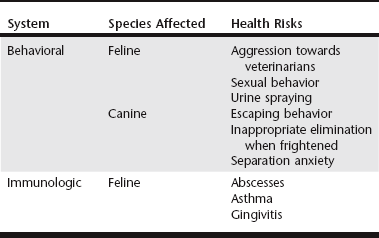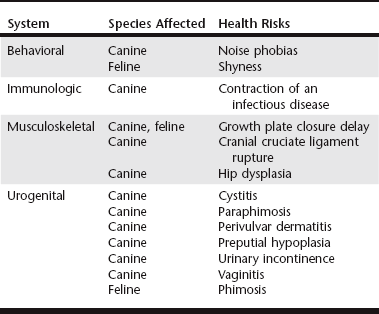Chapter 214 Although these elective surgical procedures traditionally are delayed until the patient is 6 to 7 months old (but still before puberty), mandatory preadoption neutering as early as 6 to 14 weeks of age occurs in many animal shelters throughout the United States. Recently, the Society for Theriogenology (SFT) and the American College of Theriogenologists (ACT) developed a consensus statement opposing mandatory neutering programs, stating that “the pet overpopulation problem that exists in the United States [compared to other developed countries] is due to cultural differences on the importance of pets, the responsibility of pet owners, and the ability of the government and national agencies to properly educate the public.” Early age castration is forbidden in Germany under the Law for Prevention of Cruelty to Animals (Tierschutzgesetz) (Günzel-Apel, 1998). Many veterinarians and pet owners are starting to ask, “What are the long-term effects of early age gonadectomy?” Several long-term effects must be taken into consideration. The focus of this chapter is to compare the benefits (Table 214-1) and concerns (Table 214-2) between early age and traditional age neutering of dogs and cats as well as briefly illustrate some technical differences when performing early age neutering. For the purposes of this chapter, early age neutering is defined as neutering between the ages of 6 to 23 weeks (before 6 months), and traditional age neutering is defined as neutering after 24 weeks (6 months) of age. Regardless of whether it is performed at an early or a traditional age, most elective neutering in female dogs and cats occurs prepubertally because puberty typically occurs after 8 months of age in male and female dogs and cats. Benefits and concerns of early age neutering are discussed. TABLE 214-1 Summary of Long-Term Health Risks Decreased with Early Age Neutering Compared with Traditional Age Neutering TABLE 214-2 Summary of Long-Term Health Risks Increased with Early Age Neutering Compared with Traditional Age Neutering Short-term advantages of early age neutering include a quicker recovery and shorter surgery time for the patient (Howe, 1997). Fewer surgical complications are reported when patients are neutered before 12 weeks of age compared with after 24 weeks of age (Howe, 1997). In addition, long-term benefits are associated with early age neutering. In cats, up to 70.5% of litters from owned cats are unplanned (Murray et al, 2009), and neutering these animals before adoption completely eliminates the possibility of unplanned offspring stemming from poor owner compliance of neutering at the traditional age. With respect to the health effects, cats neutered before 23 weeks of age had a decreased incidence of asthma, gingivitis, and abscesses (Spain, Scarlett, and Houpt, 2004a). Moreover, cats neutered at an early age had decreased incidence of sexual behavior, urine spraying, and aggression toward veterinarians compared with cats neutered at the traditional age (Spain, Scarlett, and Houpt, 2004a). Some investigators have found that early age neutering in dogs decreases separation anxiety, escaping behavior, and inappropriate elimination when frightened (Spain, Scarlett, and Houpt, 2004b) compared with traditional age neutering. However, the influence of the age at neutering on behavior in dogs is controversial: some investigators have found no behavioral differences between early age and traditional age neutered dogs (Howe et al, 2001).
Early Age Neutering in Dogs and Cats


Benefits
Early Age Neutering in Dogs and Cats
Only gold members can continue reading. Log In or Register to continue

Full access? Get Clinical Tree


